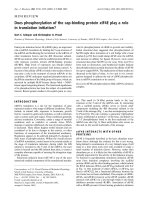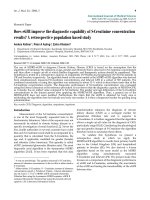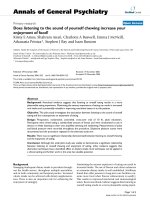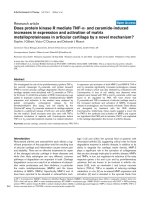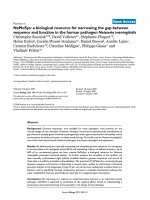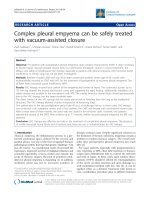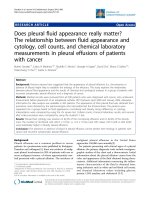Báo cáo y học: "Does pleural fluid appearance really matter? The relationship between fluid appearance and cytology, cell counts, and chemical laboratory " potx
Bạn đang xem bản rút gọn của tài liệu. Xem và tải ngay bản đầy đủ của tài liệu tại đây (397.31 KB, 5 trang )
RESEARC H ARTIC LE Open Access
Does pleural fluid appearance really matter?
The relationship between fluid appearance and
cytology, cell counts, and chemical laboratory
measurements in pleural effusions of patients
with cancer
Bulent Ozcakar
1†
, Carlos H Martinez
1,2†
, Rodolfo C Morice
1
, Georgie A Eapen
1
, David Ost
1
, Mona G Sarkiss
1,3
,
Hsienchang T Chiu
1,4
, Carlos A Jimenez
1*
Abstract
Background: Previous reports have suggested that the appearance of pleural effusions (i.e., the presence or
absence of blood) might help to establish the etiology of the effusions. Th is study explores the relationship
between pleural fluid appearance and the results of chemical and cytological analyses in a group of patients with
recurrent symptomatic pleural effusions and a diagnosis of cancer.
Methods: Medical records were reviewed from all 390 patients who were diagnosed with cancer, who underwent
thoracentesis before placement of an intrapleural catheter (IPC) between April 2000 and January 2006. Adequate
information for data analysis was available in 365 patients. The appearance of their pleural fluid was obtained from
procedure notes dictated by the pulmonologists who had performed the thoracenteses. The patients were
separated into 2 groups based on fluid appearance: non-bloody and bloody. Group differences in cytology
interpretation were compared by using the chi square test. Cellular counts, chemical laboratory results, and survival
after index procedure were compared by using the student’s t test.
Results: Pleural fluid cytology was positive on 82.5% of the non-bloody effusions and on 82.4% of the bloody
ones. The number of red blood cells (220.5 × 10
3
/μL vs. 12.3 × 10
3
/μL) and LDH values (1914 IU/dl vs. 863 IU/dl)
were statistically higher in bloody pleural effusions.
Conclusion: The presence or absence of blood in pleural effusions cannot predict their etiology in patients with
cancer and recurrent symptomatic pleural effusions.
Background
Pleural effusions are a common problem in cancer
patients. In a postmortem series published by Rodriguez-
Panadero and colleagues[1], there was evidence of malig-
nant pleural involv ement in 28% of patie nts with o ne or
more malignant tumors, of whom approximately one-
half presented with a pleural effusion. The incidence of
malignant pleural effusions in the United States
approaches 150,000 cases annually[2].
For patients presenting with clinical signs of a pleural
effusion, the primary diagnostic tools include roentgeno-
graphic studies of the chest and a thoracentesis. Initial
information about the pleural effusion comes from the
color and appearance of the fluid obtained during thora-
centesis. Additional information concerning the inflam-
matory characteristics of the fluid is obtained later,
using indicators such as white and red blood cell counts,
and chemical laboratory values including glucose,
protein, LDH, amylase, and cholesterol [3-5].
* Correspondence:
† Contributed equally
1
Department of Pulmonary Medicine, The University of Texas M. D. Anderson
Cancer Center, 1400 Hermann Pressler Dr, Unit 1462, Houston, TX, 77030-
4008, USA
Full list of author information is available at the end of the article
Ozcakar et al. Journal of Cardiothoracic Surgery 2010, 5:63
/>© 2010 Ozcakar et al; licensee BioMed Central L td. This is an Open Access article distributed under the terms of the Creative Commons
Attribution License ( .0), which permits unrestr icted use, distribution, and reproduction in
any medium, provided the original work is properly cited.
A small number of previous publications have
attempted to find an association between pleural fluid
appearance and cytological diagnosis in patients present-
ing with a pleural effusion. Two studies on patients
without a prior diagnosis of cancer reported an associa-
tion between bloody effusions and the presence of
malignant cells on pleural fluid cytology [6,7]. In a study
of patients with parapneumonic or infecti on-related
effusions, a fluid that was free-flowing and non-purulent
indicated an infection that could be treated with antibio-
tics alone, whereas a fluid with a purulent appearance
indicted the need for drainage of the affected pleural
cavity[8].
To our knowledge, there are no publications in the
medical literature evaluating the relationship between
fluid appearance and the results of cytological evaluation
and chemical laboratory testing of pleural effusions in
patients with cancer. We therefore conducted a retro-
spective study in a population of cancer patients with a
high pretest probability of having a malignant pleural
effusion (MPE) to answer two questions: Is t here any
relationship between pleural fluid appearance and the
presence of malignant cells on pleural fluid cytology?
Does fluid appearance correlate with cellular counts or
chemical laboratory measurements in pleural effusions?
Methods
Data extraction
This was a cross-sectional study in a group of patients
with symptomatic pleural effusion and a previous diag-
nosis of cancer, who had a thoracentesis prior to place-
ment of an indwelling pleural catheter (IPC). The
protocol and a waiver of informed consent were
approved by the University of Texas M. D. Anderson
Cancer Center Institutional Review Board.
Between April 2000 and January 2006, 390 patients
received a thoracentesis as part of their evaluation prior
to IPC insertion. Of this group, 365 patients had a com-
plete description of the procedure in their medical
records, including appearance of the fluid, as well as
results of cytology, cell counts, and chemical laboratory
analysis.
Medical records were reviewed to collect data on age,
gender, type of primary malignancy, number of previous
thoracentesis procedures, and results of the index proce-
dure. The index procedure was defined as the thoracent-
esis performed immediately before i nsertion of the IPC.
Pleural fluid chemical laboratory reports were reviewed
to ret rieve levels of glucose, total protein, LDH, choles-
terol, and triglycerides. Cytology results, white blood cell
count with differential, red blood cell count, and survival
after the index procedure were also recorded. Informa-
tion on pleural fluid appearance was extracted from pro-
cedure n otes available in the electronic medical record,
dictated by the pulmonary faculty who had performed
the thoracentesis. We separated patients into two groups
based on fluid appearance: bloody and non-bloody. No
purulent effusions were observed in our group.
Analysis
Age, c ell counts, and the results of chemical laboratory
analysis of pleural fluids are presented as mean values
with standard deviations and 95% confidence intervals
(95% CI) of the mean. Gender, type of primary malig-
nancy, fluid appearance, and cytology results are pre-
sented as frequencies and proportions. Differences in
pleural fluid cell counts, chemical laboratory parameters,
survival after index procedure, and cytology interpreta-
tion were compared between fluid appearance groups.
Group differences for cytolog y interpretation were com-
pared using the chi square test. Gro up differences in
cell ular counts, chemical laboratory results, and survival
after index procedure were compared using student’ s
t test and 95% CI of the mean.
Results
Demographics, t ype of primary malignancy, and pleural
fluid appearance are shown in Table 1. Almost half of
the patients had lung cancer as a primary malignancy,
followed by breast cancer (21%) and gastrointestinal
cancer (6%). Effusions were described as non-bloody in
206 patients (56.4%) and bloody in 159 patients
(43.6%). Cytology was positive in 82.5% of the patients.
Red blood cell count and LDH were the only values
significantly higher in bloody effusions (Table 2).
There was no significant association between cytology
Table 1 Demographic and clinical characteristics
Gender, n (%)
Male 165 (45.2%)
Female 200 (54.8%)
Age
Years, mean (SD) 58.7 (12.7)
Tumor type, n (%)
Lung 177 (48.5%)
Breast 76 (20.8%)
Gastrointestinal 23 (6.3%)
Leukemia 17 (4.7%)
Lymphoma 16 (4.4%)
Other tumors 56 (15.3%)
Fluid appearance, n (%)
Non-bloody 206 (56.4%)
Bloody 159 (43.6%)
Cytology, n (%)
Positive 301 (82.5%)
Negative 64 (17.5%)
Ozcakar et al. Journal of Cardiothoracic Surgery 2010, 5:63
/>Page 2 of 5
results and pleural fluid appearance at any primary
tumortype(Table3).
Discussion
Pleural fluid cytol ogy was positive on 82.5% of the non-
bloody effusions and on 82.4% of the bloody ones. The
number of red blood cells (220.5 × 10
3
/μLvs.12.3×
10
3
/μL) and LDH values (1914 IU/dl vs. 863 IU/dl) were
statistically higher in bloody pleural effusions. The pre-
sence or absence of blood in pleural effusions cannot
predict their etiolog y in patients with cancer and recur-
rent symptomatic pleural effusions.
Our study was subject to the limitations of any retro-
spective study. However, the potential effect of any
information bias is minimal, as we used pathologic and
laboratory data that were not influenced by th e clinician
or the personnel conducting the re search. Of more con-
cern is the external validity of our data. Our results are
applicable only to patients with known primary extra-
pleural malignancies presenting with a recurrent symp-
tomatic pleural effusion, not to the general patient
population with a lower pretest probability of having a
MPE. In addition, our pat ient sample did no t include
Table 2 Chemical measurements, cellular characteristics, and survival as a function of pleural fluid appearance
Characteristics Pleural Fluid Color
Non-bloody
n = 206
Bloody
n = 159
p value
Primary malignancy, No. (%)
Lung 107 (51.9%) 70 (44.0%)
Breast 45 (21.8%) 31 (19.5%)
Gastrointestinal 11 (5.4%) 12 (7.5%)
Leukemia 6 (2.9%) 11 (6.9%)
Lymphoma 10 (4.9%) 6 (3.8%)
Other tumors 27 (13.1%) 29 (18.3%)
Previous thoracentesis
Mean (95% CI) 1.7 (1.6 - 1.9) 1.8 (1.7 - 1.9) NS
Mean survival
Days (95%CI) 176.9 (141.2 - 212.6) 130.8 (101.0 - 160.6) NS
Fluid chemistry, Mean (95%CI)
Glucose (mg/dl) 102.9 (96.6 - 109.2) 93.5 (86.5 - 100.4) <0.05
Protein (g/dl) 3.8 (3.7 - 4.0) 4.1 (3.9 - 4.3) NS
LDH (IU/dl) 863.4 (680.8 - 1046.1) 1913.6 (1454.1 - 2373.1) <0.01
Cholesterol (mg/dl) 70.8 (66.3 - 75.3) 73.1 (67.8 - 78.4) NS
Cellular characteristics, Mean (95%CI)
Mean WBC 10
3
/μL 0.7 (0.6 - 0.9) 1.6 (0.9 - 2.3) <0.01
Mean RBC 10
3
/μL 12.3 (7.1 - 17.5) 220.5 (81.8 - 359.2) <0.01
PMN cells (%) 15.0 (12.0 - 18.0) 20.5 (16.5 - 24.5) <0.05
Mononuclear cells (%) 64.0 (60.0 - 68.0) 60.8 (56.3 - 65.3) NS
Cytology, No. (%)
Positive 170 (82.5%) 131 (82.4%) NS
Negative 36 (17.5%) 28 (17.6%) NS
Table 3 Cytology results as a function of pleural fluid
appearance and tumor type*
Pleural Fluid Appearance
Characteristics Non- Bloody
n = 206
Bloody
n = 159
Primary malignancy, No. (%)
Lung + Cytology 93 (86.9%) 64 (91.4%)
- Cytology 14 (13.1%) 6 (8.6%)
Breast + Cytology 40 (88.9%) 28 (90.3%)
- Cytology 5 (11.1%) 3 (9.7%)
Gastrointestinal + Cytology 11 (100.0%) 11 (91.7%)
- Cytology 0 (0.0%) 1 (8.3%)
Leukemia + Cytology 3 (50.0%) 8 (72.7%)
- Cytology 3 (50.0%) 3 (27.3%)
Lymphoma + Cytology 4 (40.0%) 6 (100.0%)
- Cytology 6 (60.0%) 0 (0%)
Other tumors + Cytology 19 (70.4%) 14 (48.3%)
- Cytology 8 (29.6%) 15 (51.7%)
*Statistical comparisons were not significant.
Ozcakar et al. Journal of Cardiothoracic Surgery 2010, 5:63
/>Page 3 of 5
any findings of “ purulent” fluids, so our conclusions do
not encompass this possibility.
It would be extremely useful if an easily assessed para-
meter like pleural fluid appearance could b e prospec-
tively used to identify patients with positive cytology or
to estimate the inflammatory or tumor burden on the
pleural space in patients with a previous diagnosis of
cancer. It would potentiall y reduce the number of inter-
ventions performed in patients with MPE prior to defi-
nitive therapy. Timely identification of the inflammatory
pleural response would also be of great interest, as some
authors have hypothe sized that the results of chemical
pleurodesis could be predic ted using cellular and chemi-
cal characteristics of the pleural fluid[9,10].
Several published studies using patients presen ting
with pleural effusions without a prior history of cancer
have found a correlation between bloody pleura l effu-
sion and malignancy. In a series of 163 patients with
large or massive pleural effusions, Porcel and Vives [11]
reported significantly higher RBC counts in patients
with MPEs compared with patients with nonmalignant
effusions (median value 18 × 10
9
cells/L versus 2.7 and
10
9
cells/L, respectively; p < 0.001).
In another prospective study of 334 consecutive
patients with chronic pleural effusion reported by Mar-
tensson and colleagues, 86% of the 44 bloody fluids and
57% of the 65 blood-tinged f luids were cancerous on
cytology or biopsy (p < 0.01) [6]. Villena and coworkers
found that the presence of a bloody fluid slightly
increased the probabi lity of a malignant pleural effusion
(Odds Ratio = 1.73). In her series of 715 patients, 47%
of the bloody effusions were MPE. The authors con-
cluded that fluid appearance should not be overempha-
sized as a diagnostic tool [7]. However, our study does
not support an extrapolation of these reports to patients
with a known history of cancer. In this study, we found
no association between pleural fluid appearance and
chemical laboratory analy sis, cell counts (except for
LDH and RBC ), or presence of maligna nt cells on cytol-
ogy i n patients with a pre vious diagnosis of cancer and
a high pretest probability of having MPE.
In our results, although 82.5% of bloody fluids showed a
positive cytology, this percentage was not significantly dif-
ferent than that observed in the non-bloody fluids (82.4%).
However, our population comprised patients with a prior
diagnosis of cancer and a higher pretest probability of hav-
ing an MPE. So, while bloody pleural effusions may be
suggestive of positive cytology in a general population of
patients presenting with pleural effusions, it does not
appear to be useful in this regard in cancer patients.
Conclusions
In summary, we found no relat ion between pleura l fluid
appearance, chemical laboratory parameters, cytological
results, or survival in patients with cancer presenting
with recurrent symptomatic pleural effusion. T herefore,
pleural fluid appearance should not be used as an indi-
cator of MPE in this patient group.
Further studies that inc lude measurements of more
specific inflammatory biomarkers are required to deter-
mine if pleural fluid appearance can predict the degree
of intrapleural inflammatory response as it could be one
of the factors related with pleurodesis success [12,13].
Acknowledgements
Eric J. Thomas, MD, MPH, reviewed the manuscript, provided guidance and
valuable suggestions.
Author details
1
Department of Pulmonary Medicine, The University of Texas M. D. Anderson
Cancer Center, 1400 Hermann Pressler Dr, Unit 1462, Houston, TX, 77030-
4008, USA.
2
Departments of Internal Medicine and Preventive Medicine and
Community Health, The University of Texas Medical Branch, Galveston, TX,
USA.
3
Department of Anesthesia and Preoperative Medicine, The University
of Texas M. D. Anderson Cancer Center, Houston, TX, USA.
4
Division of
Pulmonary Medicine, The University of Texas Southwestern Medical Center,
Dallas, TX, USA.
Authors’ contributions
BO: Conception and design of the study, collection and assembly of data,
data analysis and interpretation, manuscript writing and final approval of
manuscript. CHM: Conception and design of the study, collection and
assembly of data, data analysis and interpretation, manuscript writing and
final approval of manuscript. RCM: Conception and design of the study,
manuscript writing and final approval of manuscript. GAE: Conception and
design of the study, manuscript writing and final approval of manuscript.
DO: Conception and design of the study, manuscript writing and final
approval of manuscript. MS: Conception and design of the study, manuscript
writing and final approval of manuscript. HTC: Conception and design of the
study, manuscript writing and final approval of manuscript. CAJ: Conception
and design of the study, provision of study materials and patients, data
analysis and interpretation, manuscript writing and final approval of
manuscript.
Competing interests
The authors declare that they have no competing interests.
Received: 1 June 2010 Accepted: 18 August 2010
Published: 18 August 2010
References
1. Rodriguez-Panadero F, Borderas Naranjo F, Lopez Mejias J: Pleural
metastatic tumours and effusions. Frequency and pathogenic
mechanisms in a post-mortem series. Eur Respir J 1989, 2:366-369.
2. Antony VB, Loddenkemper R, Astoul P, Boutin C, Goldstraw P, Hott J,
Rodriguez Panadero F, Sahn SA: Management of malignant pleural
effusions. Eur Respir J 2001, 18:402-419.
3. Light RW, Macgregor MI, Luchsinger PC, Ball WC Jr: Pleural effusions: the
diagnostic separation of transudates and exudates. Ann Intern Med 1972,
77:507-513.
4. Carr DT, Power MH: Clinical value of measurements of concentration of
protein in pleural fluid. N Engl J Med 1958, 259:926-927.
5. Heffner JE: Diagnosis and management of malignant pleural effusions.
Respirology 2008, 13:5-20.
6. Martensson G, Pettersson K, Thiringer G: Differentiation between
malignant and non-malignant pleural effusion. Eur J Respir Dis 1985,
67:326-334.
7. Villena V, Lopez-Encuentra A, Garcia-Lujan R, Echave-Sustaeta J, Martinez CJ:
Clinical implications of appearance of pleural fluid at thoracentesis.
Chest 2004, 125:156-159.
Ozcakar et al. Journal of Cardiothoracic Surgery 2010, 5:63
/>Page 4 of 5
8. Sahn SA: Diagnosis and management of parapneumonic effusions and
empyema. Clin Infect Dis 2007, 45:1480-1486.
9. Chung CL, Chen YC, Chang SC: Effect of repeated thoracenteses on fluid
characteristics, cytokines, and fibrinolytic activity in malignant pleural
effusion. Chest 2003, 123:1188-1195.
10. Psathakis K, Calderon-Osuna E, Romero-Romero B, Martin-Juan J, Romero-
Falcon A, Rodriguez-Panadero F: The neutrophilic and fibrinolytic
response to talc can predict the outcome of pleurodesis. Eur Respir J
2006, 27:817-821.
11. Porcel JM, Vives M: Etiology and pleural fluid characteristics of large and
massive effusions. Chest 2003, 124:978-983.
12. Aelony Y, King RR, Boutin C: Thoracoscopic talc poudrage in malignant
pleural effusions: effective pleurodesis despite low pleural pH. Chest
1998, 113:1007-1012.
13. Rodriguez-Panadero F, Lopez Mejias J: Low glucose and pH levels in
malignant pleural effusions. Diagnostic significance and prognostic
value in respect to pleurodesis. Am Rev Respir Dis 1989, 139:663-667.
doi:10.1186/1749-8090-5-63
Cite this article as: Ozcakar et al.: Does pleural fluid appearance really
matter? The relationship between fluid appearance and cytology, cell
counts, and chemical laboratory measurements in pleural effusions of
patients with cancer. Journal of Cardiothoracic Surgery 2010 5:63.
Submit your next manuscript to BioMed Central
and take full advantage of:
• Convenient online submission
• Thorough peer review
• No space constraints or color figure charges
• Immediate publication on acceptance
• Inclusion in PubMed, CAS, Scopus and Google Scholar
• Research which is freely available for redistribution
Submit your manuscript at
www.biomedcentral.com/submit
Ozcakar et al. Journal of Cardiothoracic Surgery 2010, 5:63
/>Page 5 of 5
